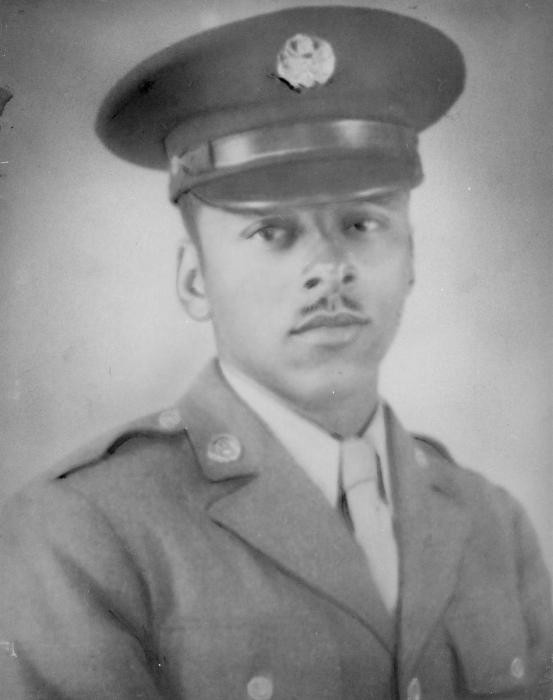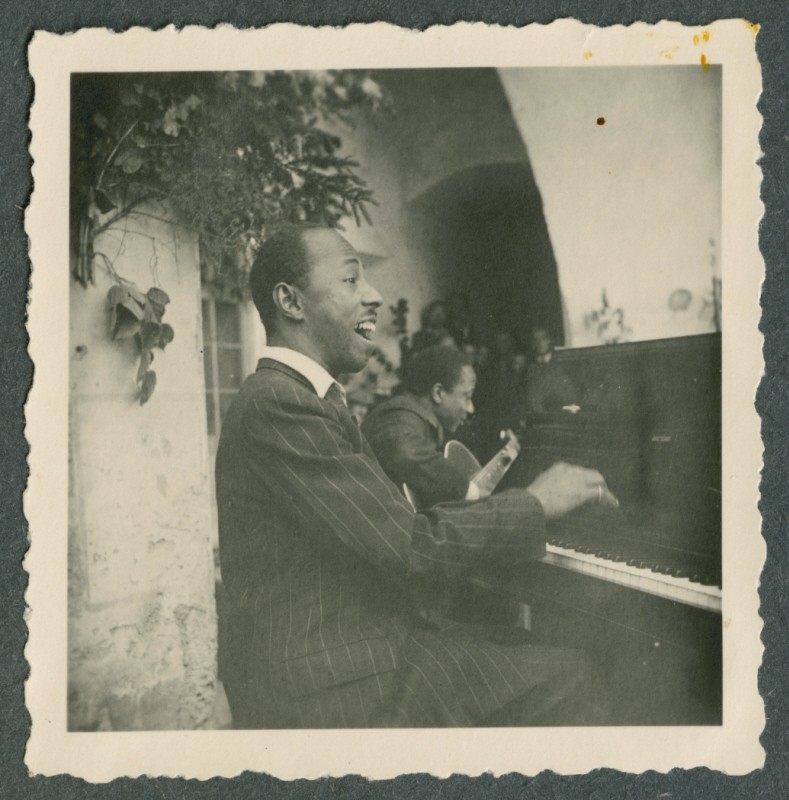African Americans in Nazi Germany
African Americans encountered the Nazis before and during World War II. Before the war, some African Americans visited Nazi Germany as tourists, Olympic athletes, or for other reasons. Many compared and contrasted racism in Nazi Germany with their experiences at home in the United States where discrimination was pervasive. During World War II, African Americans fought against the Nazis as members of the US military. Some even liberated and witnessed concentration camps.
Key Facts
-
1
Before the Nazis came to power, some African Americans lived and worked in Germany.
-
2
African Americans experienced racial prejudice and discrimination at home in the United States and as part of the American military. They also experienced racial prejudice abroad in Nazi Germany.
-
3
African American soldiers fought in the US Army during World War II. Some were taken prisoner by the German military and treated with extreme brutality. Others were members of military units that liberated and witnessed concentration camps.
Introduction

African Americans encountered the Nazis before and during World War II.
Prior to the war, these interactions primarily took place in Germany, where some African Americans lived and where others traveled to visit or work. One of the most visible prewar encounters between African Americans and the Nazi regime was the participation of African American athletes in the Olympic Games in Berlin in 1936.
During World War II, African Americans fought against the Nazis as members of the US military. They fought and died on the battlefields of Europe. They were taken prisoner and interned in prisoner-of-war camps alongside white American soldiers. African Americans were members of units that liberated and witnessed concentration camps. After the defeat of Nazi Germany in May 1945, African American soldiers remained in Germany as members of American occupation forces.
African Americans in Germany Before the Nazis
African Americans traveled to Germany in the 1920s and early 1930s. While some African Americans had come in the late 19th century, the new cultural and social atmosphere in Weimar Germany (1918–1933) was particularly appealing. People traveled from all over to attend cabarets in Berlin and study Bauhaus architecture. These visitors included African Americans.
In the 1920s, African Americans suffered discrimination in most areas of American life. In the American South, so-called "Jim Crow" laws were designed to keep Black people powerless and segregated. These laws barred African Americans from many jobs. They also prohibited African Americans from patronizing businesses that were racially segregated, including restaurants, hotels, and other facilities. In the North, discriminatory policies such as redlining were common.
There were no such laws in Weimar Germany. Thus, life was less restrictive for African Americans in Germany than at home in the United States. African Americans who could afford to travel to Germany could freely eat in restaurants, stay in hotels, and attend theatrical performances alongside white Germans.
Robert S. Abbott, the African American founder of the newspaper The Chicago Defender, visited Germany in 1929. Like most tourists, he visited museums and cafés and walked along major streets. But, he also paid close attention to race relations. He wrote about his travels in Germany on the pages of his newspaper, which was read mostly by African Americans. He also wrote about the Black people he met while there, including Black people born in Germany, Africans, and African Americans. Among the last group were an African American boxer, a jazz musician, a music student, a child artist, and an employee of the American consulate.
African American Performers in Weimar Culture
In the Weimar Republic’s atmosphere of cultural experimentation, African Americans and other Black performers found new German audiences. Jazz had spread to Germany in the aftermath of World War I. Many Germans were intrigued by new musical and dance styles originating in the United States.
In the mid- and late-1920s, numerous African American performance groups toured Europe, including Germany. One of the most famous of these tours was the Chocolate Kiddies revue, which traveled throughout Europe in 1925. It included performances by an eleven person jazz orchestra led by bandleader Sam Wooding. They performed at the large Admiralspalast theater in the center of Berlin in May 1925. Their successful advertising campaign and recorded music made a lasting impression in the city. In January 1926, singer and dancer Josephine Baker performed in La Revue nègre in Berlin.
Other African American performers regularly performed in Berlin’s venues. Among them was jazz dancer Louis Douglas. Douglas became a Berlin sensation and also appeared in two German films. He played a black soldier in the 1931 German anti-war film Niemandsland (known in English as Hell on Earth).
African Americans in Germany during the Early Years of the Nazi Regime
After the Nazis came to power in 1933, Germany was no longer as safe or appealing for African Americans. According to Nazi ideology, Black people were racially inferior. Nazi racial laws limited social and economic opportunities for all Black people in Germany, including African Americans.
Furthermore, the Nazi German regime abolished freedom of speech, press, and assembly. This affected many of the institutions and venues that had hosted African American visitors and performers. Some were even forced to close their doors permanently. Restrictions in Nazi Germany prevented African Americans from appearing in venues that continued to operate.
However, a small number of African Americans did visit Nazi Germany in the mid-1930s. In 1934, the Baptist World Alliance held its congress in Berlin. African American Baptist leaders attended, as did Black Baptist leaders from other parts of the world. Among the African Americans in attendance was a pastor who would later change his name to Martin Luther King, Sr.
In 1936, W. E. B. Du Bois, an African American scholar and civil rights activist, visited Nazi Germany. He wrote an article about his experiences, which appeared in a December 1936 issue of the Pittsburgh Courier newspaper. The article gives an eyewitness account of German antisemitism in the Nazi era. It also provides commentary on the differences between racism in the United States and the kind of racial prejudice he encountered as a Black man in Nazi Germany. In general, he wrote about the ways life was less restrictive for him as a Black visitor in Nazi Germany than it was for him in many parts of the United States.
African Americans at the Berlin Olympics, 1936
A small number of African American athletes traveled to Nazi Germany to compete in the 1936 Summer Olympics in Berlin. The Games were controversial because of the Nazi regime’s antisemitic and authoritarian policies. In fact, there had been movements in the United States and other countries to boycott the Games in Nazi Germany. During the boycott debate, African American athletes faced pressure to take a moral stand against Nazism. Having successfully trained to become Olympians, some African American athletes resented being asked not to participate.
In the end, 18 African Americans (16 men and 2 women) competed in the 1936 Olympic Games in Berlin. The most famous among them was track star Jesse Owens. The African American athletes on the team brought home 14 medals: 8 gold; 4 silver; and 2 bronze.
Jesse Owens became a role model for many African Americans. He was also a role model for Theodor Wonja Michael, an eleven-year-old Black German boy living in Berlin. Michael remembered, “The black American athlete Owens … was the star at the 1936 Berlin Olympic Games. I was lucky enough to be able to go to the stadium with my class to watch him run. He became my idol and I wanted to be like him.”
African Americans Interned as American Citizens during World War II

Nazi Germany declared war on the United States in December 1941. Afterwards, many American citizens were interned throughout Germany and German-occupied Europe as enemy aliens, since they were citizens of a country that was at war with Germany. This included some African Americans.
Among them was African American jazz musician Freddy Johnson. Johnson was detained in the German-occupied Netherlands in December 1941. He spent the war in Tittmoning internment camp before his release in a prisoner exchange in 1944. His wife Ida and his teenage daughters Marilyn and Jacqueline were separately detained. They were held in another camp in Liebenau between 1942 and 1944. In interviews after their release, Ida Johnson told reporters that she had witnessed Nazi brutality, but that she and her daughters had not been subjected to harsh treatment or violence.
In 1942, the portrait artist Josef Nassy was arrested in German-occupied Belgium as an enemy alien. Nassy was a Surinamese expatriate of Jewish descent who had managed to obtain a US passport. He was interned and held for seven months in the Beverloo transit camp in German-occupied Belgium. He was later transferred to Germany, where he spent the rest of the war in the Laufen internment camp and its subcamp, Tittmoning, both in Upper Bavaria. Conditions in these camps were much better than in concentration camps. Nassy painted and taught painting lessons. By early 1945, 850 men holding American and British passports, including a dozen Black men, were interned at Laufen and Tittmoning.
African American Soldiers during World War II
The US military was racially segregated during World War II. More than one million African Americans fought for the US Armed Forces on the homefront, in Europe, and in the Pacific. In many cases, African Americans were put into support roles, rather than in direct combat. Most American military units were racially segregated, but a few had integrated combat companies.
In Europe, African American soldiers helped defeat Nazi Germany and guarantee an Allied victory. They served in engineering, medical, and combat units, as well as support staff. A select few served as pilots, who became known as the Tuskegee Airmen. Some African American soldiers were captured and became German prisoners of war. Others were summarily executed.
Liberating and Witnessing Concentration Camps
Some African American members of the US armed forces were liberators and witnesses to Nazi atrocities. One of the liberating units was the 761st Tank Battalion (an all-African American tank unit), attached to the 71st Infantry Division, US Third Army, under the command of General George Patton. This unit participated in the liberation of Gunskirchen, a subcamp of the Mauthausen concentration camp, in May 1945. Other African American soldiers, including Leon Bass, witnessed the horrors of the concentration camps.
After battling for freedoms and defending democracy worldwide, African American soldiers returned home in 1945 only to find themselves faced with existing and pervasive prejudice and “Jim Crow” laws.

